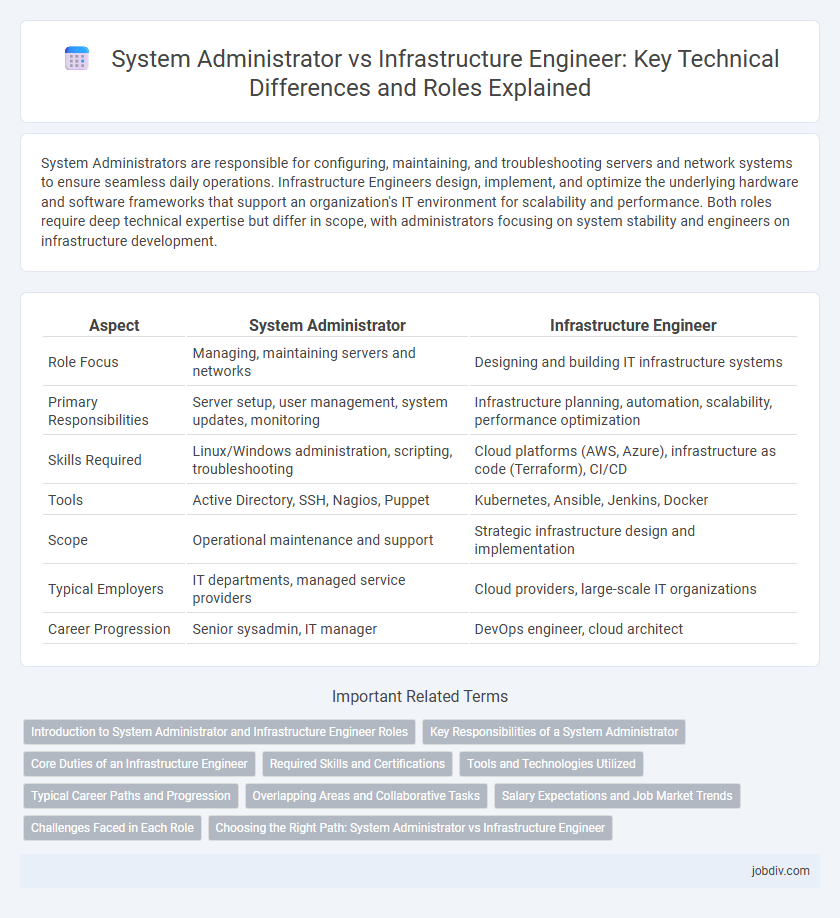System Administrators are responsible for configuring, maintaining, and troubleshooting servers and network systems to ensure seamless daily operations. Infrastructure Engineers design, implement, and optimize the underlying hardware and software frameworks that support an organization's IT environment for scalability and performance. Both roles require deep technical expertise but differ in scope, with administrators focusing on system stability and engineers on infrastructure development.
Table of Comparison
| Aspect | System Administrator | Infrastructure Engineer |
|---|---|---|
| Role Focus | Managing, maintaining servers and networks | Designing and building IT infrastructure systems |
| Primary Responsibilities | Server setup, user management, system updates, monitoring | Infrastructure planning, automation, scalability, performance optimization |
| Skills Required | Linux/Windows administration, scripting, troubleshooting | Cloud platforms (AWS, Azure), infrastructure as code (Terraform), CI/CD |
| Tools | Active Directory, SSH, Nagios, Puppet | Kubernetes, Ansible, Jenkins, Docker |
| Scope | Operational maintenance and support | Strategic infrastructure design and implementation |
| Typical Employers | IT departments, managed service providers | Cloud providers, large-scale IT organizations |
| Career Progression | Senior sysadmin, IT manager | DevOps engineer, cloud architect |
Introduction to System Administrator and Infrastructure Engineer Roles
System Administrators manage and maintain an organization's IT systems, ensuring optimal performance, security, and uptime for servers, networks, and software applications. Infrastructure Engineers design, implement, and optimize the physical and virtual IT infrastructure, including networks, data centers, and cloud solutions, to support scalable and resilient operations. Both roles require expertise in operating systems, networking, and hardware, with System Administrators focusing more on ongoing maintenance and Infrastructure Engineers on strategic infrastructure development.
Key Responsibilities of a System Administrator
System Administrators are responsible for installing, configuring, and maintaining operating systems, servers, and network devices to ensure optimal system performance and security. They manage user accounts, perform regular backups, monitor system health, and troubleshoot hardware and software issues to minimize downtime. Their key role involves implementing security protocols, applying patches, and ensuring compliance with organizational IT policies.
Core Duties of an Infrastructure Engineer
Infrastructure Engineers design, deploy, and maintain scalable IT infrastructures, ensuring reliability, performance, and security across networks, servers, and cloud environments. They automate system configurations and manage virtualized resources to optimize operational efficiency and reduce downtime. Their responsibilities include capacity planning, disaster recovery implementation, and continuous monitoring to support enterprise-level IT frameworks.
Required Skills and Certifications
System Administrators require strong knowledge of operating systems, network protocols, and scripting languages such as PowerShell or Bash, with certifications like CompTIA Network+ and Microsoft Certified: Windows Server. Infrastructure Engineers must possess expertise in cloud platforms (AWS, Azure), virtualization technologies, and infrastructure as code tools like Terraform, often validated by certifications such as AWS Certified Solutions Architect and Cisco CCNP. Both roles demand proficiency in security best practices and troubleshooting, but Infrastructure Engineers emphasize design and deployment of scalable systems.
Tools and Technologies Utilized
System Administrators primarily utilize tools such as configuration management software like Ansible and Puppet, monitoring systems including Nagios and Zabbix, and virtualization platforms like VMware and Hyper-V to maintain and optimize server environments. Infrastructure Engineers focus on cloud services such as AWS, Azure, and Google Cloud Platform, container orchestration with Kubernetes and Docker, and Infrastructure as Code (IaC) tools like Terraform to design, deploy, and scale network infrastructure. Both roles require proficiency in scripting languages like Python or Bash to automate workflows and improve system efficiency.
Typical Career Paths and Progression
System Administrators typically begin their careers managing server configurations, network troubleshooting, and user support, gradually advancing to senior sysadmin roles involving automation and security management. Infrastructure Engineers often start with designing and implementing scalable network architectures and cloud infrastructures before progressing to roles centered on strategic system optimization and large-scale deployment projects. Career progression in both paths increasingly emphasizes proficiency in cloud platforms such as AWS, Azure, and containerization technologies like Docker and Kubernetes.
Overlapping Areas and Collaborative Tasks
System Administrators and Infrastructure Engineers share responsibilities in managing network systems, ensuring server stability, and maintaining security protocols. Both roles collaborate on deploying updates, monitoring system performance, and troubleshooting hardware or software failures to minimize downtime. Their synergistic efforts enhance IT infrastructure resilience and optimize resource allocation within organizational environments.
Salary Expectations and Job Market Trends
System Administrator roles typically offer salaries ranging from $60,000 to $90,000 annually, with demand steady in small to medium enterprises focused on maintaining existing IT systems. Infrastructure Engineers command higher salaries, often between $85,000 and $130,000, reflecting their advanced expertise in designing and optimizing complex network architectures. The job market trends indicate increasing growth for Infrastructure Engineers driven by cloud adoption and digital transformation, while System Administrator positions remain essential but face automation pressure.
Challenges Faced in Each Role
System Administrators often face challenges related to maintaining system uptime, troubleshooting software and hardware issues, and managing user access permissions across diverse platforms. Infrastructure Engineers encounter complexities in designing scalable network architectures, integrating cloud services, and ensuring security compliance within evolving infrastructure landscapes. Both roles require continuous adaptation to emerging technologies and proactive problem-solving to minimize system disruptions.
Choosing the Right Path: System Administrator vs Infrastructure Engineer
System Administrators specialize in maintaining and optimizing servers, networks, and user support, ensuring seamless daily operations and system reliability. Infrastructure Engineers focus on designing, implementing, and scaling complex IT frameworks involving cloud platforms, automation, and virtualization technologies to support organizational growth. Selecting between these roles depends on whether you prefer operational maintenance with direct user interaction or strategic infrastructure development with advanced technical innovation.
System Administrator vs Infrastructure Engineer Infographic

 jobdiv.com
jobdiv.com